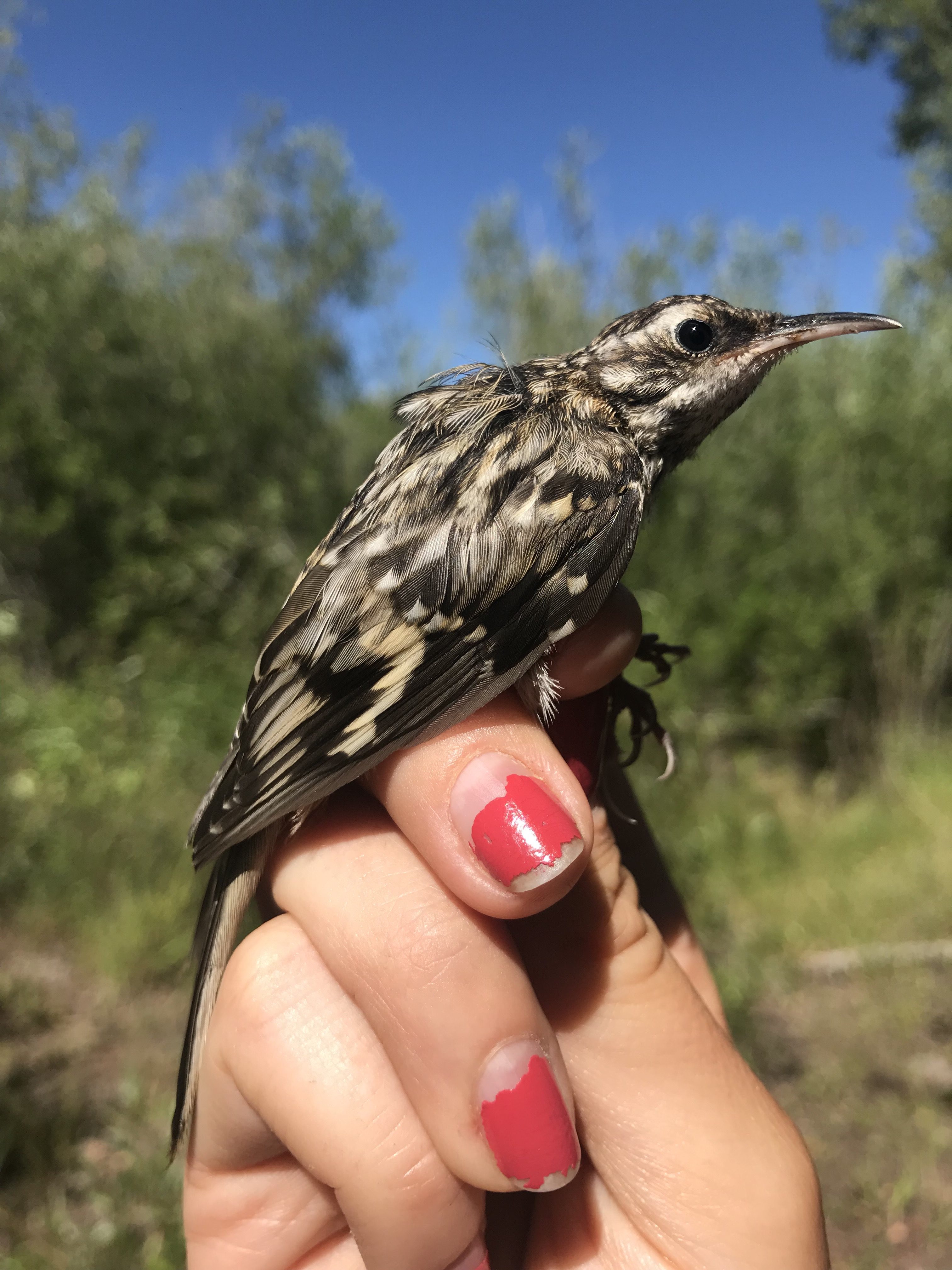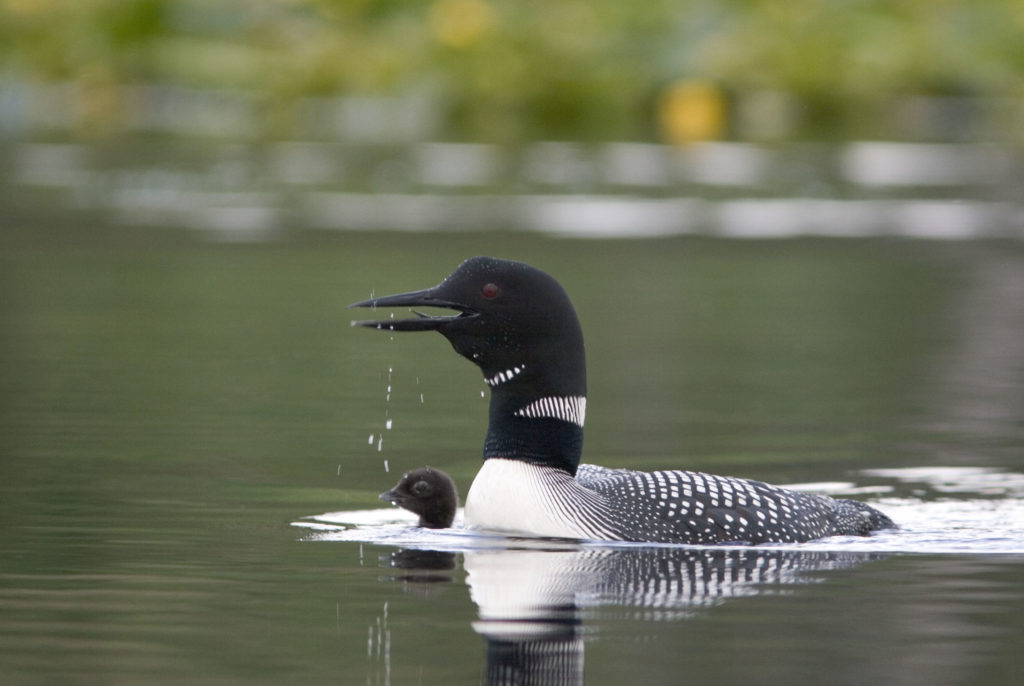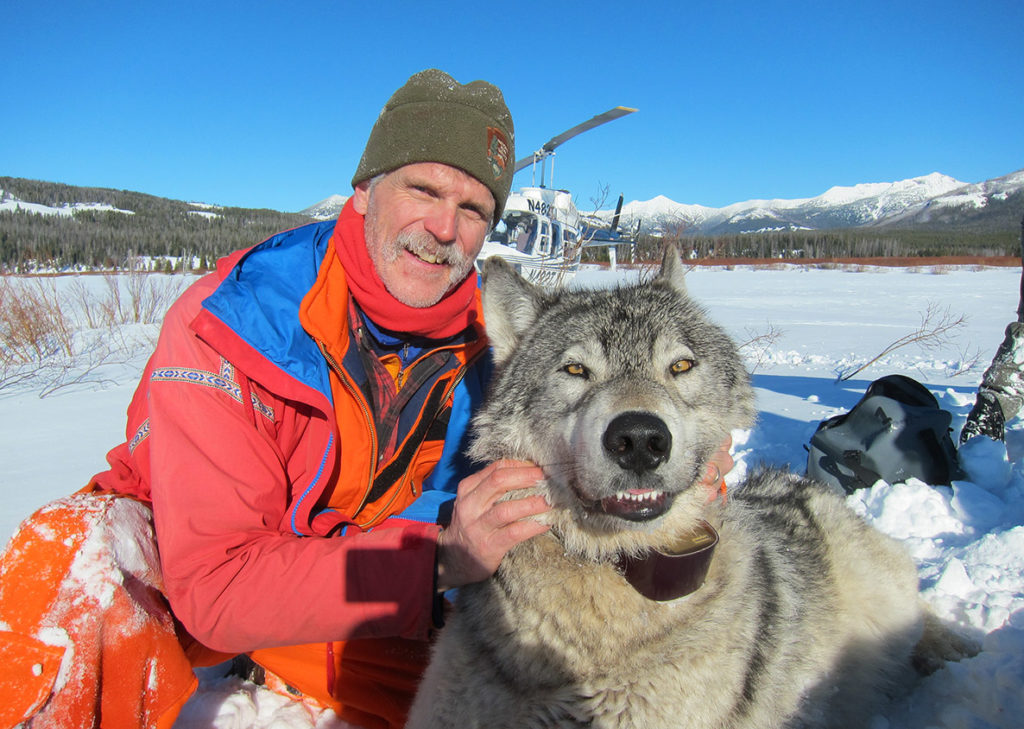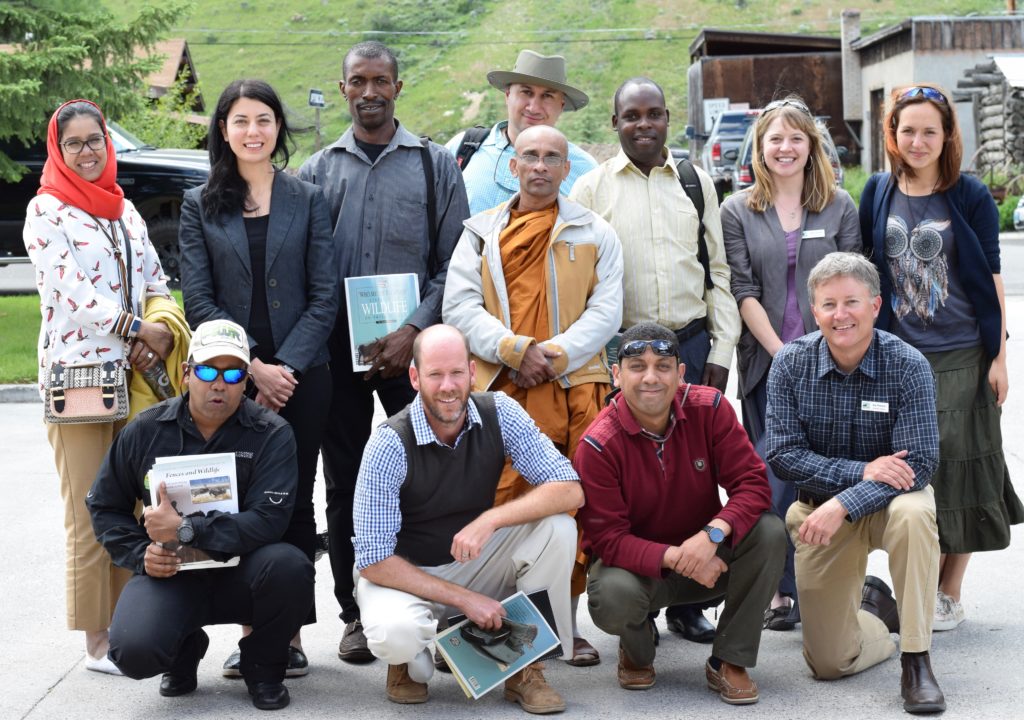
by jhwildlife | Aug 24, 2018 | Blog
by Max Frankenberry, Assistant Bird Bander
After nine weeks of banding birds this summer, JHWF’s first MAPS season has officially come to an end. Every Wednesday and Friday sunrise, from June 6th to August 3rd, was spent setting up nets, collecting data on the birds we caught, and attaching small aluminum USGS-issued bands to their legs. All in all, this season produced 677 total bird captures, with 453 new birds banded this season.
Bird banding is a highly-effective research method used worldwide for tracking bird movement, survival rates, and reproduction success. Banders are trained in specialized bird handling, safety, and data collection, and can only legally band birds if covered under state and federal permits. Each band number is unique to each individual bird. Banders report both new bands placed on previously unbanned birds, and bands that are on birds that they recapture after already being banded before. Other data like age, sex, weight, and various conditions are also collected and reported, forming the massive database of information that USGS and various ornithological groups manage and analyze.

Lead Bird Bander Kate Maley attempts to age this Red-shafter Flicker (Colaptes auratus) by inspecting flight feather characteristics

Assistant Bird Bander Max Frankenberry measures the wing chord length of a Yellow Warbler (Setophaga petechia) Photo credit: David Hopkins
MAPS stands for Monitoring Avian Productivity and Survivorship. It is a specific banding program begun by the Institute for Bird Populations (IBP), with a goal of better understanding survival rate and nesting success while birds are at their summer breeding grounds. JHWF bands birds following IBP protocol — opening nets at sunrise and closing them six hours later — and submits data to the IBP database. This builds on the years of previous data collected on birds in Jackson Hole from Teton Science Schools (TSS) and Teton Raptor Center (TRC), who helped transition the program to us this year. Our two banding locations, Teton Science Schools’ Kelly campus and Boyle’s Hill on their Jackson campus, have been contributing data without a break in observations for 28 and 16 years respectively. Kelly is one of the longest operating MAPS stations in the country! Long-term, uninterrupted data sets are crucial to understanding trends in bird population shifts. Thanks again to TSS and TRC for making the transitions between organizations so smooth!
The 2018 season ended with 180 recaptures (out of 677 total captures) of previously banded birds, with several of these birds having been banded even before the 2017 season. Much like years before and not surprising to those of us that live in Jackson Hole, our most popular species caught were Yellow Warblers and American Robins (AMROs). In total, 109 new Yellow Warblers (or YEWAs in banding code) had bands placed on their legs this year, many of them young birds born this summer. YEWAs are doing just fine in our valley! American Robins were our second most common bird this year, with 57 new birds banded. While we had constant flows of incoming YEWAs and AMROs, we also had a few particularly exciting individuals as well. By far the most unexpected were a pair of Belted Kingfishers, each caught a week apart from each other! While kingfishers are not uncommon here, they are rarely caught in banding stations, mostly due to their preference for flying much higher than the nets and perching on trees overhanging water.

Male Belted Kingfisher (Megaceryle alcyon)

Female Belted Kingfishers have a rusty belly band (Megaceryle alcyon)

Belted Kingfishers have detailed white patterns on their flight feathers – we can use these to figure out how old the birds are!
We were excited to say the least. Other species that graced us with their surprising presence were a very vocal Olive-sided Flycatcher and a juvenile Brown Creeper. We also had 40 birds that were captured and released but not banded, including large number of Rufous, Calliope and Broad-tailed Hummingbirds (our banding permit does not allow hummingbird banding – that requires additional specialized training). Overall we captured 45 different species of birds over 9 weeks. This guaranteed that we never had a slow morning at either banding station!
Other wildlife sightings always kept us on our toes throughout the season – early mornings at Kelly and Boyle’s Hill allowed us views of several moose and calves, foxes, a grizzly bear, a family of otters, and even an elusive mountain lion! Sunrise work with birds in the Greater Yellowstone Ecosystem meant bear spray and our favorite badly-sung show tunes had to always be at the ready.

Olive-sided Flycatcher (Contopus cooperi)

Male Black-headed Grosbeak (Pheucticus melanocephalus)

Juvenile Brown Creeper (Certhia americana)
We want to thank all who have made this program possible. This effort to track birds in our valley really does contribute extremely valuable data to a great continent-wide program. The MAPS data has resulted in many highly regarded publications on the state of bird populations in North America and new ways to manage and preserve them. Thanks for being “for the birds”!
Below is a full list of the species we captured and banded this season. Look them up and try to spot some of them in your own backyard!
- Calliope Hummingbird
- Broad-tailed Hummingbird
- Rufous Hummingbird
- Belted Kingfisher
- Red-naped Sapsucker
- Downy Woodpecker
- Red-shafted Flicker
- Olive-Sided Flycatcher
- Western Wood-Pewee
- Willow Flycatcher
- Dusky Flycatcher
- Warbling Vireo
- Violet-Green Swallow
- Black-Capped Chickadee
- Mountain Chickadee
- Red-breasted Nuthatch
- White-breasted Nuthatch
- Brown Creeper
- House Wren
- Golden-crowned Kinglet
- Ruby-crowned Kinglet
- American Robin
- Swainson’s Thrush
- Hermit Thrush
- Gray Catbird
- Cedar Waxwing
- Orange-crowned Warbler
- Yellow Warbler
- Audubon’s Warbler
- MacGillivray’s Warbler
- Wilson’s Warbler
- Western Tanager
- Black-headed Grosbeak
- Green-tailed Towhee
- Brewer’s Sparrow
- Chipping Sparrow
- Mountain White-Crowned Sparrow
- Fox Sparrow
- Song Sparrow
- Dark-eyed Junco
- Brown-headed Cowbird
- Bullock’s Oriole
- Cassin’s Finch
- Pine Siskin
- American Goldfinch

by jhwildlife | May 16, 2018 | Blog, Nature Mapping Jackson Hole

Three mule deer does and a fawn spotted on the Sept. 10, 2017 float trip. Photo credit: Forest Dramis.
A quick step into the dory and a careful shifting of weight with binoculars raised and off we go, five lucky Nature Mappers floating the Snake River on a sparkling Sunday morning. We glide swiftly and smoothly under the Wilson Bridge (with the chittering of swallows and clamor of traffic overhead) and emerge, calling out: “Two, no three Ravens!” “16 Tree Swallows, I think? They move fast.” “Look, a Great Blue Heron!” “No, Osprey!” “Both!”
As we flow downstream, we scan the shorelines, water and sky, and settle into intervals of excitement and tranquility. A designated Nature Mapper jots down the tally for common species and takes GPS points for unusual sightings. A morning’s count can include eight Bald Eagles, a moose, numerous Spotted Sandpipers, Common Mergansers, Yellow Warblers, nesting Bank Swallows and a flotilla of American White Pelicans. Or perhaps we spy a marmot family basking on a rock, or a beaver up a backwater.
For seven years, Nature Mappers have been gathering data on wildlife thanks to A.J. DeRosa, owner of Jackson Hole Vintage Adventures. A.J. donates his handcrafted wooden dory and an expert boatman every Sunday morning from May to October. With this opportunity for consistent data collection, Nature Mappers have been able to record trends and shifts in species’ numbers and locations over the summer months (May-October), year to year. We are beginning to discern patterns in species’ migrations, nesting locations, and possibly, with time, impacts of flooding, dike vegetation management and river use.
These results are possible thanks to over four-dozen trained nature mappers and friends participating each year. Ace volunteer Tim Griffith schedules the teams and often adds his expertise on the floats. Since Tim started coordinating the trips with A.J., many species’ sightings have increased significantly. Tim has a fine ear and eye for the birds! Please read Tim’s 2017 Nature Mapping Jackson Hole Snake River Float Trip Annual Report here. It includes a species list and numbers; the special conditions of 2017 during the spring flood and its effect; and the season’s variation in eagle numbers. Be sure to contact Tim if you wish to volunteer on a Snake River Float Trip this summer!

An idyllic setting, Jackson Hole Vintage Adventures Tipi Camp is a wildlife rich habitat Photo credit: Forest Dramis

by jhwildlife | Sep 15, 2017 | Blog, Nature Mapping Jackson Hole
by Susan Patla, Non-game biologist for WGFD and NMJH Science Advisory Committee member
The call of a loon echoing across a still mountain lake is a sound that embodies the essence of wilderness. Biodiversity Research Institute (BRI), in partnership with Yellowstone and Grand Teton National Parks and Wyoming Game & Fish Department (WGFD), recently completed a fifth field season to monitor and study common loons in Wyoming. This project has been funded through a generous grant by the Ricketts Conservation Fund to determine the conservation status of loons in Wyoming and four other states. The loon is the rarest nesting bird species in Wyoming and a designated species of conservation concern. The Wyoming population is also the most southern nesting group in North America and isolated from the nearest neighboring population in Montana by over 200 miles. While migrating loons can be seen across the state both in spring and fall, breeding pairs currently occur only in the northwest part of the state.

Since 1987, Yellowstone NP and WGFD have been monitoring the presence of loon pairs and fledged chicks. In 2013, BRI expanded on this effort through increased monitoring of pairs during the nesting season and the capture and banding of adult loons. In 2017, there were 21 territorial pairs documented (15 of which were in Yellowstone), and at least 12 of these attempted to nest. Eight pairs successfully hatched a total of ten chicks and all survived to fledging. Seven unpaired adults and one immature loon were also seen. One territorial female adult was captured and banded, and young were banded at two additional sites. Results from blood and feather samples for mercury and genetic analyses will be available later. BRI also deployed nest rafts at four sites and worked with agencies to implement management measures to protect nesting pairs.

Compared to 2016, Wyoming had one fewer territorial pair and productivity was slightly lower than previous years. Nest success was affected this year by the above average snowfall, and late ice-out on many of the nesting lakes which were still frozen in early June. Rapid runoff resulted in flooding at a few sites also. Surveys of many backcountry lakes were also restricted in the early season due to lingering deep snow conditions. Productivity, however, over the study period has been above the 0.48 chicks surviving per territorial pair needed for population stability. Loons have been seen in recent years in the Wind River Range although no nesting pairs have been found. In the future, translocation of chicks may be considered to help expand the nesting population in Wyoming. Major threats to this population include human disturbance of nest sites, drought, and water quality. Mercury contamination, which has been a problem in New England loons, does not appear to be affecting Wyoming loons. All documentation of loons by Nature Mappers is greatly appreciated by BRI and the partner agencies to help in understanding the distribution and movements of this magnificent bird.
Click the image to enlarge and back button to get back to post. Photos by Mark Gocke, WGFD.

by jhwildlife | Feb 18, 2017 | Blog, Nature Mapping Jackson Hole

Join us for an annual celebration of our wildlife-friendly community of citizen scientists. The supervisor of the Yellowstone wolf, bird and elk programs Doug Smith will present ‘Yellowstone wolves: the first 20 years’ about wolf population dynamics, wolf-prey relationships, trophic cascades and wolf-human interactions (hunting).
Have some fun and bring a dish to share: Last Name: A-K Main Dish, L-P Side or Salad, Q-Z Dessert
*You are welcome to join us even if you cannot provide a dish
• Nature Mapping Potluck Dinner at 6 pm and Presentation at 7
• At Center for the Arts
• MC: Dawson Smith, Spring Creek Ranch Naturalist Program Director; Jackson Hole Wildlife Foundation Board Member
• March 22, 5:30 pm doors open
• Cost: Free (bring some cash for great raffle items!)
Enter a raffle drawing to win from a selection of great items generously offered by in-kind supporters (tickets are 1 for $5, 5 for $10, 10 for $30).
TIMELINE:
5:30 pm – Doors open
• Raffle items and silent auction on display
• Learn about becoming a Nature Mapper and see what our collective observations reveal in maps that are on display
• Drinks available at cash bar
6 pm – Potluck dinner begins
6:50 pm – Raffle ends
7 pm – Presentation in auditorium features Doug Smith
Thanks to the Meg and Bert Raynes Wildlife Fund and the entire Nature Mapping community for making the evening possible.
SILENT AUCTION ITEMS AND RAFFLE PRIZES:
Silent Auction Items:
• Henry Holdsworth Framed Print of Wolves – Last of the Druids donated by Wild by Nature Gallery
• Breakfast with Eagles Float Trip donated by Jackson Hole Vintage Adventures
• Teton Pines Golfing for Four package donated by Teton Pines Country Club
• Lost Creek Ranch Cookout donated by Lost Creek Ranch
Raffle Prizes:
• Bert Raynes Bird Lovers Package (Special edition of Birds of Sage and Scree, Birds of Jackson Hole, and Far Afield DVD)
• National Park Service Annual Pass & Gift Basket donated by Grand Teton Association
• Spring Creek Ranch – One-Night Stay + Breakfast & Dinner for 2 donated by Spring Creek Ranch
• 2 Day Passes to Jackson Hole Mountain Resort donated by Jackson Hole Mountain Resort
• 5-Pack Yoga Class Card donated by Teton Yoga Shala
• Big R gift card donated by Big R Jackson Hole
• Nature Mapping Jackson Hole Hat and T-shirt

by jhwildlife | Jun 23, 2016 | Blog, Nature Mapping Jackson Hole

In June, JHWF was visited by a group of conservation professionals from Argentina, Russia, Iran, Sierra Leone, Malaysia, South Africa, Morocco, Sri Lanka, Oman and Zimbabwe. This group was supported by the International Visitor Leadership Program of the U.S. Department of State and hosted by our friends at the Wyoming Council for International Visitors.
Traveling with the objective of assessing U.S. efforts to protect biodiversity, JHWF was pleased to spend an hour with our new colleagues talking about wildlife-friendly communities. There was great interest in learning more about the citizen science effort throughout the valley and how the Nature Mapping program was designed. Citizen science is not (yet) a strong practice in many other countries, but there is growing interest to engage the public in conservation science. We said that one of the keys to launching a successful citizen science effort is to have a “champion,” such as the admired and beloved Bert Raynes, to inspire an initial following.
A visiting biologist from Morocco inquired about the bluebird nest boxes he observed along the Elk Refuge fence. “I noticed more tree swallows than bluebirds as we drove into town,” he said. His observation concurred with our findings in recent weeks, as many of the Mountain Bluebirds and their fledglings had left the boxes, though a few remain. While we delighted in the fact that nearly every representative expressed interest in introducing a variation of Nature Mapping in their country, we also couldn’t help but recognize the common joy we all derive from our interactions with wildlife – a universal bond.
It was an interesting discussion comparing and contrasting our conservation challenges and subsequent efforts around the world. While our working contexts might differ in terms of political, social and economic influences, a consistent thought existed amongst our diverse group – the belief that by removing or reducing barriers we humans have created (obsolete barbed wire fencing, for example), we can moderate our impact on wildlife and live more compatibly within a healthy environment that sustains all life.

























